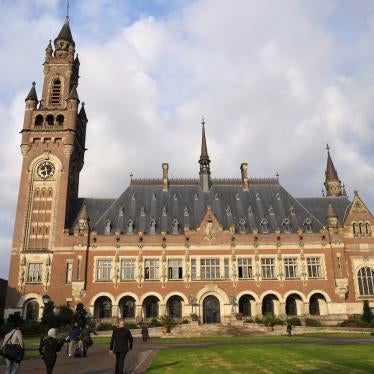For weeks, the Syrian Air Force had been bombing the Damascus suburb of Daraya. But on the morning of Nov. 16, 2012, something was different.
An anti-government activist who filmed the attack told my organization, Human Rights Watch, that MiG fighter jets dropped large bombs that opened mid-air to release smaller bombs that would “catch fire while they were still in the air.” When these “fireballs” fell to the ground, they continued to burn intensely, emitting thick plumes of smoke. This was one of the first documented instances of the Syrian government’s use of incendiary weapons, which produce heat and fire through the chemical reaction of a flammable substance.
Two weeks later, in the center of town in Quseir in western Syria, video shot immediately after an airstrike showed the same ZAB-2.5 incendiary submunitions burning on a school playground. It’s not clear if the school was in use at the time, but the attack wounded at least 20 civilians, according to local activists.
Over the past year, the Syrian Air Force has carried out at least 56 incendiary weapons attacks, based on our field investigations, witness accounts and a review of extensive video and photo evidence. It is not possible to comprehensively document the harm that these incendiary weapons have inflicted on civilians, but in four separate attacks at least 41 civilians were killed and 71 wounded.
One of the most infamous incendiary weapons is napalm. Many still remember the image taken 40 years ago of a 9-year-old girl running naked, her burned skin hanging from her body, after a U.S.-backed South Vietnamese airstrike dropped napalm on her village. The girl, Kim Phuc, was screaming, “Too hot! Too hot!” according to Nick Ut, who took the photo for the Associated Press. In the decade that followed this attack, public revulsion at the shocking injuries that napalm inflicted in Southeast Asia helped motivate the adoption of new international humanitarian law to restrict the use of napalm and other incendiary weapons.
Yet today in Syria, children are still suffering from these weapons. As demonstrated in Vietnam, and again now in Syria, incendiary weapons cause extremely painful burns that are difficult to treat, and start destructive fires.
Dr. Saleyha Ahsan, a British emergency medicine doctor, was volunteering at a hospital in Aleppo governorate on Aug. 26 when badly burned children began arriving after an airstrike. One 15-year-old boy had gone to pick up his sister from school after a bomb fell on an apartment building nearby. As he was waiting outside the entrance, the MiG jet fighter returned to drop another bomb that fell on the school courtyard, splashing a burning, napalm-like substance all over him. The youth was covered in burns and crying out in pain, saying, “I want to sleep,” Dr. Ahsan said. His sister was not hurt. The Violations Documentation Center in Syria, a Syrian group that has been documenting human rights violations, reported that the attack killed more than three dozen civilians, mostly children attending the secondary school.
There is no doubt that Syrian government forces are responsible for dropping the incendiary bombs. Witness accounts and video evidence show fixed-wing jet aircraft and helicopters operated by the Syrian Air Force are being used to deliver incendiary weapons. The opposition rebels lack air power.
Yet unlike in 1972, there has been no public outcry. Where are the diplomatic efforts to address these weapons? Syria’s air strikes using incendiary weapons in or near civilian population centers are indiscriminate attacks that violate international humanitarian law. They might be war crimes. All countries should condemn Syria’s use of incendiary weapons, just as they have its use of chemical weapons and cluster bombs.
This week, government delegates are meeting at the United Nations in Geneva to consider the 1980 Convention on Conventional Weapons, including its Protocol III, which bans the use of air-delivered incendiary weapons in areas with “concentrations of civilians.” Syria is not party to the protocol, which is the sole international instrument dealing explicitly with incendiary weapons. A total of 107 countries have joined, including all five permanent members of the U.N. Security Council. The Syrian government’s use of incendiary weapons shows the urgent need to bring all nations on board the protocol, but also to strengthen the existing law.
Given the horrific injuries that incendiary weapons inflict, it has to be asked: Why are these weapons permitted under any circumstances? A total prohibition would provide maximum protection to civilians.
Mary Wareham (@marywareham) is the arms division advocacy director at Human Rights Watch.









